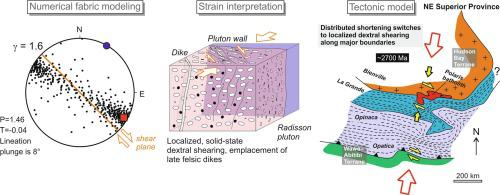Precambrian Research ( IF 3.2 ) Pub Date : 2021-07-27 , DOI: 10.1016/j.precamres.2021.106322 Jiří Žák 1 , Filip Tomek 1, 2 , Martin Svojtka 2 , František Vacek 1, 3 , Václav Kachlík 1 , Lukáš Ackerman 2 , Josef Ježek 4 , Michael S. Petronis 5

|
The Canadian Superior Province has become one of the key test pieces to discuss tectonic processes and mechanisms of crustal growth in the Late Archean. The Province consists of a >2.8 Ga proto-cratonic core intruded by voluminous arc-like plutons and surrounded by a series of narrow, elongate ca. 2.8–2.7 Ga juvenile belts, also referred to as terranes or domains. The terranes seem to wrap around the proto-cratonic core and generally young outward, but the kinematics and geodynamic causes of their assembly remain debated. In this paper, we examine the Radisson pluton in northeastern Québec, which intruded the southern, outer edge of the presumed magmatic arc (Bienville domain) along its ~WNW–ESE-trending tectonic boundary with the proto-cratonic crust (La Grande domain). The pluton, dominated by porphyritic monzogranite to quartz monzonite, was emplaced at around 2712 Ma and exhibits complex internal structure resulting from superposed magmatic to solid-state deformations. An early margin-parallel ~WNW–ESE magmatic foliation containing a steep lineation, recognized by the anisotropy of magnetic susceptibility (AMS), is interpreted as recording vertical stretching and horizontal flattening of highly crystallized magma, either due to emplacement and/or pure shear dominated transpression. More widespread, however, is a horizontal lineation within the same foliation that is interpreted as recording post-emplacement, but still syn-magmatic, tectonic strain (~NNE–SSW shortening and boundary-parallel stretching). Upon cooling, localized dextral S–C mylonite zones accommodated further shortening within the pluton whereas undeformed late-stage felsic dikes cross-cut the solid-state fabric at an angle to the pluton margins. We suggest that this structural succession, also reproduced by numerical fabric modeling, is a local-scale signal of a two-stage assembly of the northeastern Superior Province: the frontal, NNE-directed terrane convergence and attachment to the cratonic nucleus, operating in a ‘hot’ regime with voluminous arc-like plutonism, was followed by more localized dextral shearing parallel to terrane boundaries. The latter phase is recorded at the proto-craton margin but also in the outboard Abitibi greenstone belt virtually at the same time (ca. 2700–2690 Ma). In combination, the two-stage evolution and similar deformation distributed over a broad region resemble modern large hot orogens formed in a plate-tectonic regime.
中文翻译:

加拿大东北部苏必利尔省的分布地壳缩短,随后是横压剪切:太古代晚期与现代增生板块边缘的类比?
加拿大优越省已成为讨论太古代晚期构造过程和地壳生长机制的关键试验片之一。该省由一个 > 2.8 Ga 的原克拉通核心组成,被大量弧形岩体侵入,周围环绕着一系列狭窄、细长的约。2.8-2.7 Ga 幼年带,也称为地体或域。这些地体似乎环绕着原始克拉通核心,向外通常很年轻,但它们聚集的运动学和地球动力学原因仍然存在争议。在本文中,我们研究了魁北克东北部的 Radisson 岩体,它沿着其与原克拉通地壳(La Grande 域)的~WNW-ESE 走向构造边界侵入了推测的岩浆弧(Bienville 域)的南外边缘. 岩体以斑状二长花岗岩到石英二长岩为主,位于 2712 Ma 左右,表现出复杂的内部结构,这是由叠加的岩浆到固态变形造成的。早期边缘平行~WNW-ESE 岩浆叶理包含陡峭的线状结构,由磁化率各向异性 (AMS) 识别,被解释为记录高度结晶岩浆的垂直拉伸和水平扁平化,这是由于就位和/或纯剪切占主导地位的压榨。然而,更普遍的是同一叶理内的水平线状结构,它被解释为记录了侵位后,但仍然是同岩浆构造应变(~NNE-SSW 缩短和边界平行拉伸)。冷却后,局部右旋 S-C 糜棱岩带在岩体内进一步缩短,而未变形的晚期长英质岩脉以与岩体边缘的角度横切固态结构。我们认为,这种结构演替也是通过数值结构模型再现的,是苏必利尔省东北部两阶段集会的局部尺度信号:锋面、NNE 导向的地体汇聚并附着在克拉通核上,在具有大量弧状深成体作用的“热”状态,随后是平行于地体边界的更局部的右旋剪切。后一阶段记录在原克拉通边缘,但几乎同时记录在阿比蒂比绿岩带外侧(约 2700-2690 Ma)。结合,











































 京公网安备 11010802027423号
京公网安备 11010802027423号